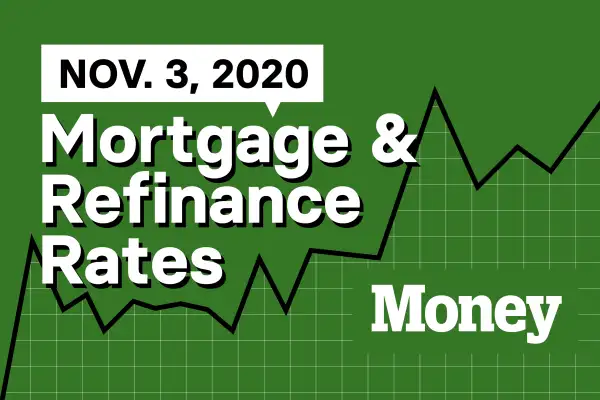Here Are Today's Best Mortgage & Refinance Rates for November 3, 2020

The average rate for a 30-year fixed-rate purchase mortgage was 3.438% on Monday. The average rate for a 30-year refinance was 4.273%.
Money's current mortgage rates include data from over 8,000 lenders across the United States and are updated daily. These rates include discount points and represent what a borrower with a 20% down payment and 700 credit scores — roughly the national average FICO score — would have been quoted.
| 30-year fixed-rate purchase mortgage |
| 3.438% |
| Rate of November 2, 2020 |
Mortgage rates vary from state to state. On Monday, borrowers in Arkansas were quoted the lowest mortgage rates — at 3.294%. People looking for mortgages in Nevada saw the highest average rate at 3.684%. Nationwide, borrowers with the highest credit scores, 740 and above, were quoted rates averaging 2.981%, while those with credit of 640 or below were shown rates of 4.694% — a 1.713 percentage-point spread.
You may be able to negotiate a lower rate if you shop around or if you have other accounts with the lender. (Money's picks for the best mortgage lenders are here.) Currently, some banks are hiking up advertised rates to keep demand in check, so you may be offered a lower rate if you reach out directly.
Freddie Mac's widely quoted Primary Mortgage Market Survey put rates at 2.81% with 0.6 points paid for the week ending October 29. The mortgage purchaser's weekly survey reflects borrowers who put 20% down on conforming loans and have excellent credit.
Refinance rates today
Money's survey also shows that the offered rate for a 30-year refinance for someone with a 740 credit score was 3.671% on Monday. Last November, the average mortgage rate (including fees) was 3.874%.
| 30-year fixed-rate mortgage refi |
| 3.671% |
| Rate of November 2, 2020 |
A homeowner with a $200,000 mortgage balance currently paying 3.874% on a 30-year could potentially cut their monthly payment from $940 to $917 by financing at the current lower rates. To determine if it's worth it to refinance your mortgage, also consider the closing fees you paid on your current mortgage, how much your new lender is charging and how long you have left on your loan term. (Our picks for the best lenders for refinancing are here).
What else is happening in the housing market right now?
Last month, U.S. home prices accelerated at the fastest annual pace since May of 2014, increasing by 6.7% year-over-year, according to CoreLogic's Home Price Index. Compared to August prices were up 1.1%.
Higher than usual home buying activity continued into the late summer months, as first time buyers and those who were able to transition to remote work took advantage of record-low mortgage rates. According to previously released data from the National Association of Realtors and the U.S. Census Bureau, housing inventory reached the lowest level ever in September, with the available inventory at 40% of the 2008 level and 75% of the number of homes on the market in 2000.
"COVID has contributed to the acute shortage of inventory as the pace of new construction slowed and older prospective sellers postponed listing their homes until after the pandemic," said Frank Nothaft, chief economist for CoreLogic. "Once the pandemic passes or a vaccine is widely administered, we should see a noticeable pick-up in for-sale homes. And if the economy's recovery is sluggish next year, distressed sales may also add to market inventory."
CoreLogic is forecasting price acceleration to slow to 0.2% over the next twelve months as eroding affordability and increased inventory temper home price appreciation.
Elsewhere, homeowners continue exiting forbearance plans at a steady pace. According to the Mortgage Bankers Association, the share of loans in forbearance dropped 7 basis points from 5.90% to 5.83% of all loans for the week ending October 25. The MBA estimates there are currently 2.9 million homeowners still in the payment deferral plans.
"The share of loans in forbearance has returned to levels last seen in early April, but still remain remarkably high," said Mike Fratantoni, chief economist for the MBA. "Further improvement will require ongoing recovery in the job market, as well as additional fiscal stimulus."
The decline occurred across all loan types. The share of Fannie Mae and Freddie Mac improved for the 21st consecutive week, decreasing by 6 basis points to 3.66%. Ginnie Mae loans, which had been on the increase until recently, were down 4 basis points to 8.13%, while the share of portfolio loans and private-label securities decreased by 8 basis points to 8.82%.
Almost half of the loans exiting the deferral program to date have been homeowners who either remained current while in forbearance or who were reinstated by paying back past due amounts. Of the loans that still remain in forbearance, 24% were in the initial stage, while 74% were in a forbearance extension. The remaining 1.56% were loans that had exited forbearance and then re-entered the program.
Mortgage Prediction of the Week
Expert views on what comes next.
Jeff Tucker, economist for online listing site Zillow, on how long home prices will continue to Rise:
Home prices will rise 3.2% in the next year. That forecast is the result of our projection of two countervailing forces in the housing market: persistently high unemployment will depress demand for homes eventually, and will push some homeowners into distressed sales and foreclosures next spring. On the other hand, the incredibly low inventory on the market is forcing buyers to compete for the same limited selection of homes, giving sellers the upper hand in negotiations for now. Overall, we see such astoundingly low inventory and enough Millennial buyers entering prime ages to buy their first homes, armed with record-low interest rates, that prices will not dip at all in this recession."
For more on home prices, read: How Long Will Home Prices Continue to Rise? 8 Experts Weigh In.
Bottom line:
Savvy Homebuyers Are Using an Under-the-Radar Strategy to Win Bidding Wars in 2020
New Construction Home Sales Are Soaring, but Financing a Purchase Can Be Tricky
Rates are subject to change. All information provided here is accurate as of the publish date.

